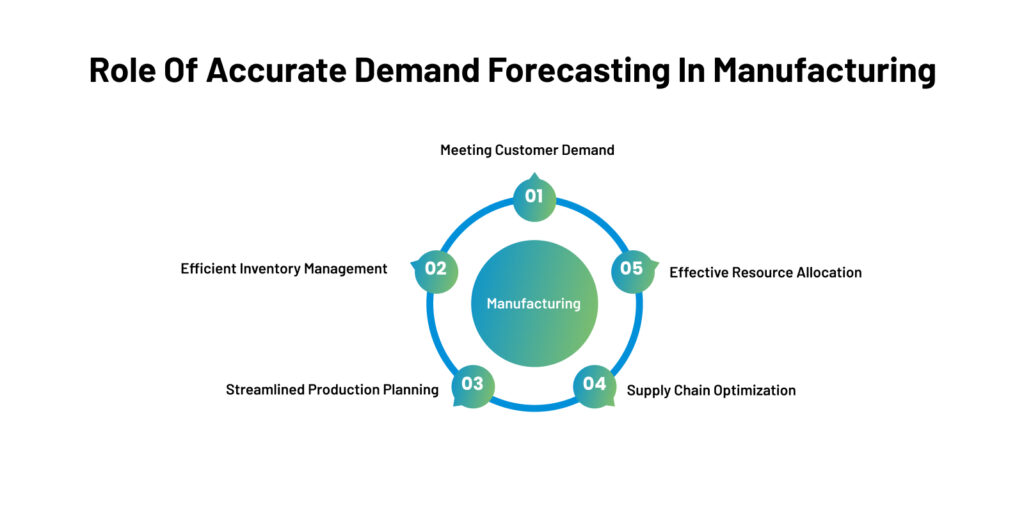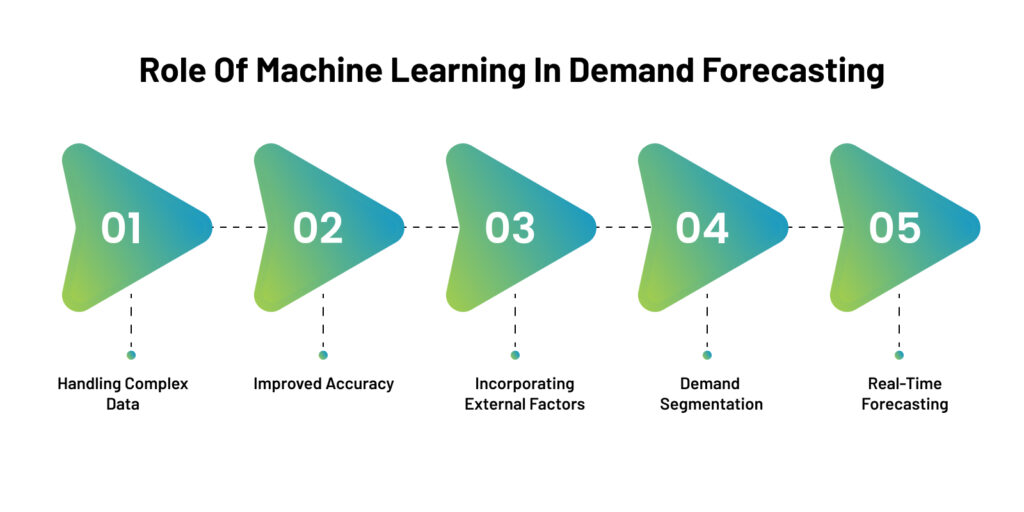In the highly competitive manufacturing world, accurately predicting customer demand is critical to maintaining a competitive edge. However, traditional demand forecasting methods often struggle to keep pace with the complexities and nuances of today’s dynamic market landscape. As a result, manufacturers face challenges such as excess inventory, stockouts, and suboptimal production planning, leading to significant financial implications and customer dissatisfaction.
Enter machine learning—a powerful technology that has revolutionized the field of demand forecasting. Manufacturers now have the opportunity to transform their demand forecasting processes and unlock invaluable insights by harnessing the computational prowess and advanced analytical capabilities of machine learning algorithms.
In this blog, we will explore how machine learning reshapes demand forecasting in the manufacturing sector, drives operational efficiency, and propels businesses toward greater success. We will delve into the key principles, methodologies, and practical applications of machine learning in demand forecasting, providing you with the knowledge to leverage this cutting-edge technology within your organization.
But before we get to the intricacies of ML in demand forecasting, let’s understand what demand forecasting is.
Also, Read – How Industry 4.0 Technologies are Changing Manufacturing
Overview of Demand Forecasting in Manufacturing
Demand forecasting in manufacturing is estimating the future demand for a product or service based on historical data, market trends, and other relevant factors. It involves analyzing past sales patterns, customer behavior, economic indicators, and external influences to predict the demand for goods or services.
Demand forecasting aims to give manufacturers valuable insights into the expected demand levels, allowing them to make informed decisions regarding production planning, inventory management, resource allocation, and overall business strategy.
By accurately forecasting demand, manufacturers can optimize their production schedules, minimize inventory costs, and ensure customer satisfaction. This process involves leveraging techniques such as statistical modeling, time series analysis, market research, and collaboration with sales and marketing teams.
Demand forecasting also plays a crucial role in supply chain management, enabling manufacturers to efficiently align their procurement, production, and distribution processes to meet anticipated customer demand. An effective demand forecasting system ultimately empowers manufacturers to streamline operations, reduce waste, and enhance their competitive advantage in the dynamic manufacturing landscape.
Furthermore, the importance of demand forecasting in manufacturing extends beyond operational efficiency and cost savings. It also influences strategic decision-making and long-term business success. How? Let’s understand.
Role of Accurate Demand Forecasting in Manufacturing
Predicting customer demand for products or services within a specified time frame allows manufacturers to align their production, inventory management, and supply chain processes accordingly. Manufacturers can make informed decisions and optimize their operations by leveraging historical data, market trends, and advanced forecasting techniques, improving customer satisfaction, minimizing costs, and increasing profitability.

Meeting Customer Demand:
Accurate demand forecasting enables manufacturers to anticipate customer needs and fulfill orders promptly. Manufacturers can adjust their production schedules, capacity, and resources by understanding the expected demand patterns. This ensures that products are readily available when customers require them, minimizing stockouts, backorders, and customer dissatisfaction. Timely delivery of products also enhances brand reputation and customer loyalty, paving the way for sustainable growth.
Efficient Inventory Management:
Demand forecasting plays a critical role in optimizing inventory levels. Manufacturers can maintain an optimal balance between inventory holding costs and stock availability by accurately predicting demand. Excessive inventory ties up valuable capital increases warehousing costs, and poses the risk of obsolescence. On the other hand, insufficient inventory leads to missed sales opportunities and potential customer churn. Accurate demand forecasting helps manufacturers avoid these pitfalls and achieve efficient inventory management, reducing costs and maximizing profitability.
Streamlined Production Planning:
Demand forecasting serves as a foundation for effective production planning. By aligning production schedules with anticipated demand, manufacturers can optimize their manufacturing processes, raw material procurement, and workforce utilization. This allows for improved resource allocation, minimized waste, and increased productivity. Moreover, accurate demand forecasting helps manufacturers identify potential bottlenecks or capacity constraints, enabling proactive measures to address them and maintain smooth operations.
Supply Chain Optimization:
Demand forecasting facilitates efficient supply chain management by providing insights into expected demand fluctuations. Manufacturers can collaborate with suppliers, distributors, and logistics partners to ensure timely and cost-effective procurement, transportation, and distribution of goods. Accurate forecasts enable manufacturers to negotiate favorable terms, streamline logistics routes, and avoid unnecessary expenses associated with expedited shipments or last-minute changes. Optimized supply chain management contributes to enhanced operational efficiency and customer satisfaction.
Effective Resource Allocation:
Accurate demand forecasting enables manufacturers to allocate resources effectively. By understanding future demand trends, manufacturers can make informed decisions regarding workforce planning, machinery utilization, and capacity expansion. This helps avoid overstaffing or understaffing, optimize equipment utilization, and make strategic investments to meet future demands. Effective resource allocation ensures manufacturers operate at peak efficiency, reducing costs and maintaining a competitive edge.
By predicting customer demand with precision, manufacturers can streamline their production, inventory management, and supply chain processes, leading to improved customer satisfaction, minimized costs, increased profitability, and a stronger competitive position in the market. Manufacturers should take key steps to enhance their demand forecasting capabilities and drive overall manufacturing efficiency and success by embracing advanced forecasting techniques and technologies, leveraging data analytics, and continuously refining forecasting models.
But before leveraging new tech and tools, why not have a sneak peek into the traditional demand forecasting methods?
Traditional Demand Forecasting Methods
Traditional demand forecasting techniques are widely used to predict future demand patterns based on historical data and other relevant factors. These techniques have been employed in various industries and sectors to guide production, inventory management, supply chain optimization, and resource allocation decision-making. While these methods have been somewhat effective, they have limitations and challenges. Here are some key points regarding the limitations and challenges of traditional demand forecasting techniques:

Reliance on historical data: Traditional techniques heavily rely on historical data to forecast future demand. This assumption can be problematic when significant shifts or disruptions in the market, such as changes in consumer behavior, new product introduction, or disruptive technologies. Historical data may not adequately capture these dynamics, leading to inaccurate forecasts.
Lack of real-time data integration: Traditional methods cannot often incorporate real-time data into the forecasting process. As a result, they may not fully capture the impact of evolving market conditions, seasonal variations, or sudden events like natural disasters or economic crises. The absence of timely data integration limits the accuracy and responsiveness of traditional techniques.
Inability to handle complex relationships: Traditional methods typically assume linear relationships between variables, which may not hold in complex and dynamic business environments. They may not capture non-linear relationships, interdependencies between different factors, or the influence of external factors that affect demand. This limitation can result in inaccurate forecasts, especially in industries with high demand volatility or complex market dynamics.
Limited ability to incorporate qualitative factors: Traditional techniques often focus on quantitative data and may struggle to incorporate qualitative factors that impact demand, such as consumer preferences, brand perception, and market trends. Ignoring these qualitative factors can lead to incomplete and less accurate forecasts.
Sensitivity to outliers and anomalies: Traditional methods can be sensitive to outliers and anomalies in historical data. If unusual events or outliers occur during the data collection, they can significantly affect the forecasting models, leading to distorted predictions. This limitation becomes particularly relevant when dealing with limited historical data or facing exceptional market conditions.
Difficulty handling product lifecycle changes: Traditional techniques may face challenges when forecasting product demand at different stages. Traditional methods may not adequately capture new product introductions, product obsolescence, or changes in consumer demand patterns, resulting in inaccurate forecasts and suboptimal decision-making.
Manual intervention and subjectivity: Some traditional forecasting techniques require manual intervention and subjective judgment. This introduces the risk of human bias, inconsistency, and errors in the forecasting process. Additionally, manual methods can be time-consuming, mainly when dealing with large datasets or complex forecasting models.
Lack of adaptability and agility: Traditional methods may lack the flexibility to adapt quickly to changing market conditions or to incorporate new data sources and technologies. This rigidity can hinder generating accurate and timely forecasts in dynamic and rapidly evolving industries.
Addressing these limitations and challenges has led to the development of advanced forecasting techniques, such as machine learning algorithms, predictive analytics, and demand sensing models, which aim to overcome the shortcomings of traditional methods by leveraging real-time data, incorporating non-linear relationships, and enhancing forecasting accuracy.
Further, let’s finally explore the significance of machine learning in demand forecasting, starting with understanding machine learning in manufacturing.
Introduction to Machine Learning in Manufacturing
Machine learning is a branch of artificial intelligence that enables computers to learn and make predictions or decisions without being explicitly programmed. Machine learning techniques have gained significant attention in the manufacturing industry due to their potential to enhance efficiency, productivity, and decision-making.
Machine learning algorithms can analyze vast amounts of data generated in manufacturing operations and extract meaningful insights. These insights can optimize various aspects of the manufacturing process, such as quality control, predictive maintenance, supply chain management, and demand forecasting.
Machine Learning Algorithms in Manufacturing
- Supervised Learning: In supervised learning, machine learning algorithms are trained on labeled data to make predictions or classifications. In manufacturing, this can be used for quality control by training models to identify defective products based on labeled examples. It can also be used for predictive maintenance, where algorithms learn from labeled data to predict equipment failures.
- Unsupervised Learning: Unsupervised learning involves training machine learning algorithms on unlabeled data to identify patterns or groupings. In manufacturing, unsupervised learning can be used for anomaly detection, where algorithms identify abnormal behavior or patterns in sensor data that may indicate faults or defects in the manufacturing process.
- Reinforcement Learning: Reinforcement learning involves training an algorithm to make decisions in an environment and learning from feedback or rewards. In manufacturing, reinforcement learning can optimize production processes by training algorithms to make decisions that maximize efficiency or minimize waste.
Role of Machine Learning in Demand Forecasting
Demand forecasting is critical to manufacturing operations, as it helps companies plan production, manage inventory, and optimize resources. Machine learning techniques can significantly improve demand forecasting accuracy by leveraging historical data, external factors, and market trends.
Here’s how machine learning can enhance demand forecasting in manufacturing:

Handling Complex Data: Machine learning algorithms excel at processing and analyzing vast amounts of data, including structured and unstructured data from various sources. This capability allows manufacturers to leverage data from sales records, customer interactions, social media, market trends, and other relevant sources to gain comprehensive insights into demand patterns. By considering various factors, machine learning models can capture complex relationships and make more accurate forecasts.
Improved Accuracy: Traditional demand forecasting methods rely on historical data and assumptions about future trends. Machine learning, on the other hand, uses advanced statistical techniques to identify patterns and correlations in data automatically. By continuously learning from new data and adjusting predictions, machine learning models can provide more accurate and reliable forecasts, reducing errors and improving planning decisions.
Incorporating External Factors: Machine learning models can integrate external factors influencing demand, such as holidays, economic indicators, weather conditions, or competitor activities. By considering these factors, machine learning algorithms can capture their impact on consumer behavior and adjust forecasts accordingly. For example, a machine learning model may recognize that demand for inevitable products increases during specific seasons or promotional events, allowing manufacturers to plan production and inventory accordingly.
Demand Segmentation: Machine learning can identify distinct customer segments based on purchasing patterns, preferences, and behaviors. Manufacturers can better understand customer groups and their specific needs by segmenting demand. Machine learning models can generate demand forecasts for each segment, enabling more targeted production planning and inventory management strategies. This approach helps manufacturers allocate resources effectively, optimize product offerings, and tailor marketing efforts to specific customer groups.
Real-Time Forecasting: Machine learning algorithms can provide real-time demand forecasts, allowing manufacturers to respond quickly to market changes. Machine learning models enable manufacturers to adapt their production plans, adjust inventory levels, and promptly respond to customer demand shifts by continuously analyzing incoming data and updating predictions. Real-time forecasting helps manufacturers minimize stockouts, reduce excess inventory, and improve overall supply chain efficiency.
Machine learning is vital in demand forecasting within the manufacturing industry. By leveraging advanced algorithms and techniques, machine learning enables manufacturers to handle complex data, improve forecast accuracy, incorporate external factors, segment demand, and provide real-time forecasts. These capabilities empower manufacturers to make informed decisions, optimize resources, and meet customer demands effectively in today’s dynamic and competitive business environment.
Also, Read – How AI and Machine Learning Transform Inventory Management in Logistics
Conclusion:
In the manufacturing industry, the application of machine learning for advanced demand forecasting has the potential to revolutionize operations and drive significant improvements in efficiency, productivity, and customer satisfaction. Manufacturers can extract valuable insights from complex data, improve forecast accuracy, and make informed decisions to optimize their production and inventory strategies by leveraging machine learning algorithms.
As we look toward the future, the role of machine learning in demand forecasting is poised to become even more critical. With the advent of Industry 4.0 solutions and the ongoing digital transformation in manufacturing, the opportunities for leveraging machine learning will continue to expand.
Manufacturers will increasingly rely on digital transformation consultants and consulting services to navigate the complex landscape of implementing machine learning for demand forecasting. These experts will help organizations identify the most relevant data sources, develop robust machine learning models, and integrate them seamlessly into existing operations. The collaboration between manufacturing experts and digital transformation consultants will be crucial in unlocking the full potential of machine learning for demand forecasting.
One future trend is the integration of Internet of Things (IoT) devices and sensors within manufacturing operations. By collecting real-time data from machines, products, and supply chains, machine learning models can capture more granular information and enhance the accuracy of demand forecasts. This integration will enable manufacturers to detect anomalies, optimize maintenance schedules, and respond promptly to fluctuations in demand.
Another trend is using predictive analytics with machine learning for demand forecasting. Predictive analytics techniques, such as time series analysis and regression modeling, can complement machine learning algorithms by providing additional insights into demand patterns. By combining the strengths of both approaches, manufacturers can achieve more robust and accurate forecasts.
Additionally, the availability of cloud computing resources and scalable machine learning platforms will play a significant role in the future of advanced demand forecasting. These technologies allow manufacturers to leverage high-performance computing capabilities, access large-scale data storage, and deploy machine learning models at scale. As a result, manufacturers can handle massive volumes of data, accelerate model training, and achieve real-time forecasting capabilities.
In conclusion, leveraging machine learning for advanced demand forecasting in manufacturing is a game-changer. It enables manufacturers to make data-driven decisions, optimize production, and meet customer demands effectively. With the continued advancements in Industry 4.0 solutions, the expertise of digital transformation consultants, and the integration of IoT and predictive analytics, the future of machine learning in demand forecasting looks promising. By embracing these trends, manufacturers can stay ahead of the competition, drive innovation, and unlock new opportunities in the dynamic manufacturing world.




